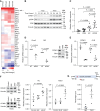KRAS Promotes GLI2-Dependent Transcription during Pancreatic Carcinogenesis
- PMID: 38896052
- PMCID: PMC11232480
- DOI: 10.1158/2767-9764.CRC-23-0464
KRAS Promotes GLI2-Dependent Transcription during Pancreatic Carcinogenesis
Abstract
Aberrant activation of GLI transcription factors has been implicated in the pathogenesis of different tumor types including pancreatic ductal adenocarcinoma. However, the mechanistic link with established drivers of this disease remains in part elusive. In this study, using a new genetically engineered mouse model overexpressing constitutively active mouse form of GLI2 and a combination of genome-wide assays, we provide evidence of a novel mechanism underlying the interplay between KRAS, a major driver of pancreatic ductal adenocarcinoma development, and GLI2 to control oncogenic gene expression. These mice, also expressing KrasG12D, show significantly reduced median survival rate and accelerated tumorigenesis compared with the KrasG12D only expressing mice. Analysis of the mechanism using RNA sequencing demonstrate higher levels of GLI2 targets, particularly tumor growth-promoting genes, including Ccnd1, N-Myc, and Bcl2, in KrasG12D mutant cells. Furthermore, chromatin immunoprecipitation sequencing studies showed that in these cells KrasG12D increases the levels of trimethylation of lysine 4 of the histone 3 (H3K4me3) at the promoter of GLI2 targets without affecting significantly the levels of other major active chromatin marks. Importantly, Gli2 knockdown reduces H3K4me3 enrichment and gene expression induced by mutant Kras. In summary, we demonstrate that Gli2 plays a significant role in pancreatic carcinogenesis by acting as a downstream effector of KrasG12D to control gene expression.
©2024 The Authors; Published by the American Association for Cancer Research.
Conflict of interest statement
All authors have completed and submitted the ICMJE Form for Disclosure of Potential Conflicts of Interest. E.L. Schenk reports personal fees from CDR-Life, WC Communications, OncLive, Third bridge, Medscape, Amgen, Boehringer Ingelheim, IDEOlogy Health, Harpoon, Takeda, Slingshot Insights, Thetis Pharmaceuticals, Janssen, Curio Science, Global Data, BeiGeneius, Chameleon Communications, Horizon CME, AstraZeneca, Axon Advisors, The Scienomics Group, BioAtla, MJH Life Sciences, Regeneron, MedPro, G1 Therapeutics, Prescient Advisory, Actinium, Guidepoint Global, and ClearView outside the submitted work. A.L. Oberg reports grants from NIH NCI and The Lustgarten Foundation for Pancreatic Cancer Research during the conduct of the study. R.P. Graham reports other from Bristol Myers Squibb and Astellas outside the submitted work. No disclosures were reported by the other authors.
Figures




References
Publication types
MeSH terms
Substances
Grants and funding
LinkOut - more resources
Full Text Sources
Medical
Molecular Biology Databases
Research Materials
Miscellaneous

